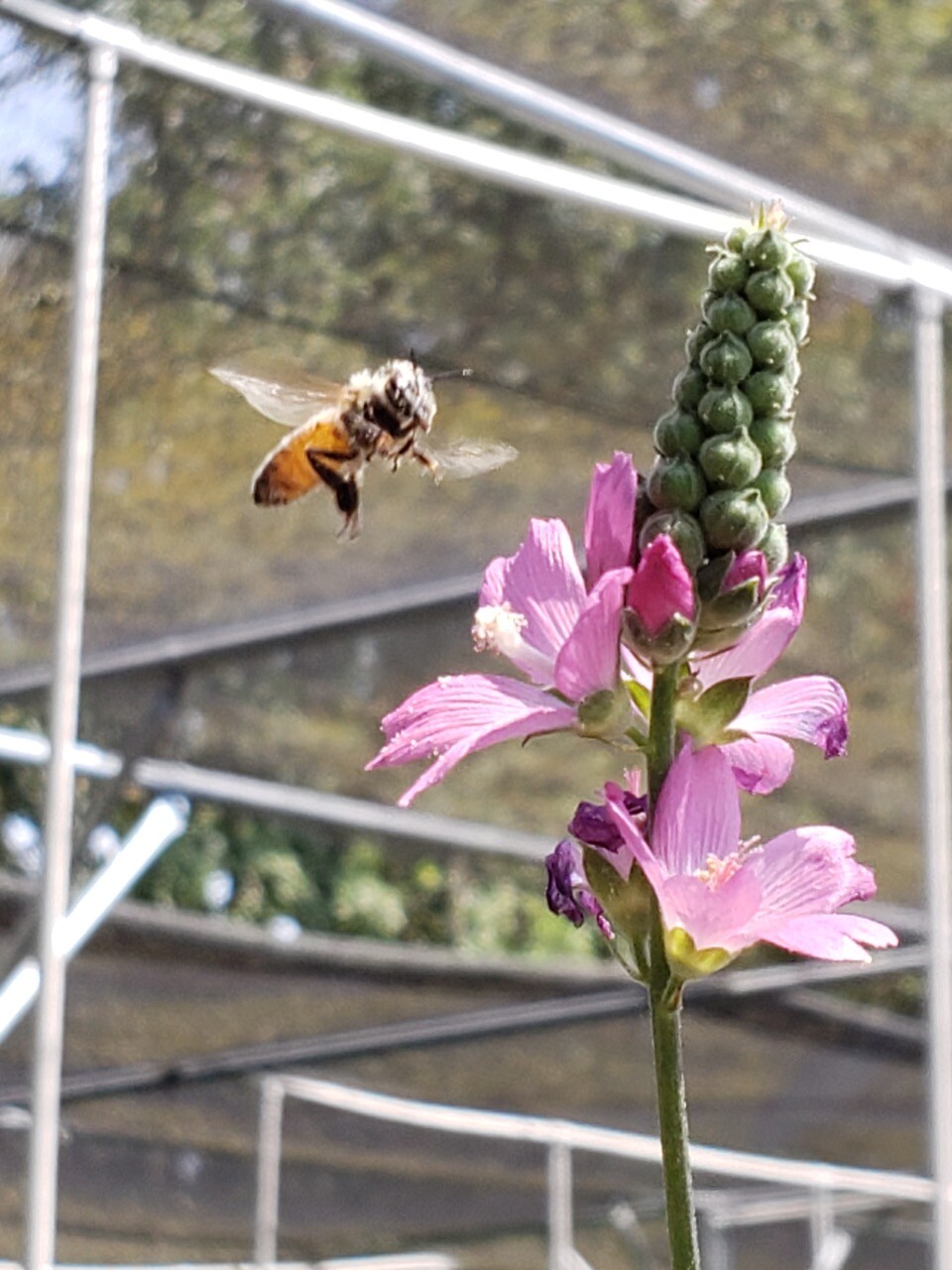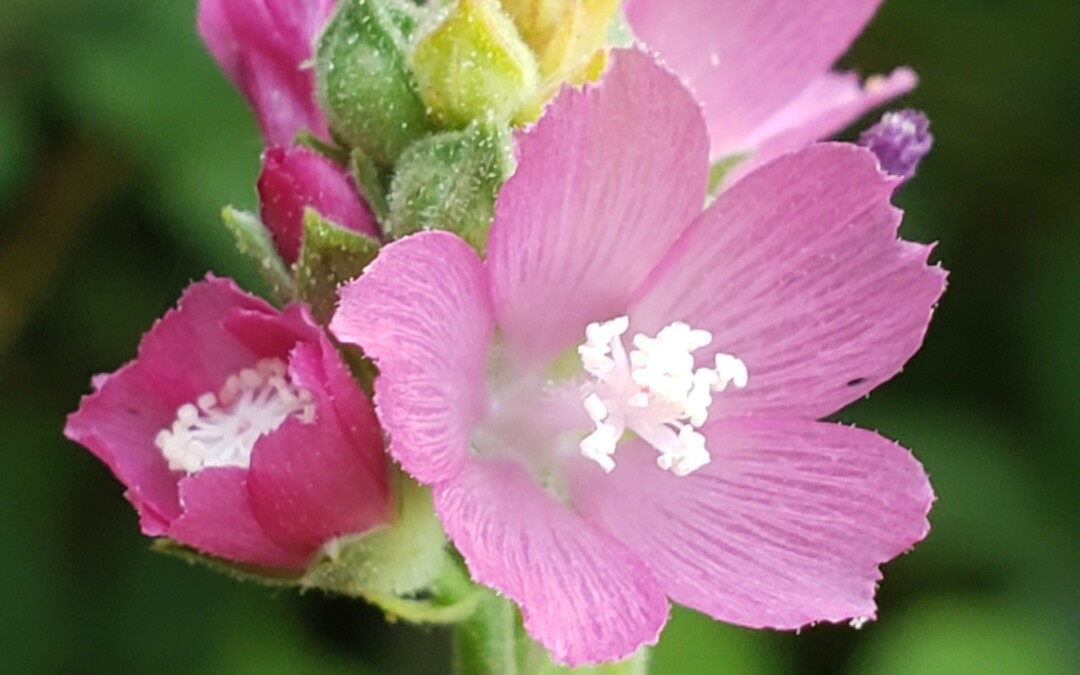On a cool February morning, a joint team of eight from Sonoma Ecology Center (SEC) Restoration, SEC Research, and biologists from CDFW Native Plant Program came together in the Kenwood Marsh to help save a very special plant, the Kenwood Marsh Checkerbloom (commonly known as the Checkermallow) Sidalcea oregana ssp. valida, by implementing critical weeding and dethatching. A designated endangered plant species, the Kenwood Marsh Checkerbloom has been a subject of close attention for multiple programs of SEC to attempt to ensure a more secure future for this endemic and eye-catching wildflower with that can grow from three to four feet tall with deep pink blooms that show up from late June to September. As our dedicated readers and supporters may remember, SEC has been working in concert with CDFW and the landowner of Deerfield Ranch Winery to whom it is owed special thanks for their partnership in helping this species survive for multiple seasons – with propagation efforts occurring at our native plant nursery at the Sonoma Garden Park and in the field conservation efforts occurring seasonally.


This shoulder season is a special time of year for many of our native plants emerging from their dry season slumber to grow with winter and spring rains (if they arrive!). Young plants face a laundry list of challenges: aggressive non-native species can choke out young regrowth and sprouts by shading them from the sun and consuming precious water and nutrients. At the same time, the thatch of fast growing local plants like sedge (Carex sp.) and rush (Juncus sp.) provide great hiding places for burrowing animals that love to nibble on the tender young plants. A third year of drought may further imperil this critically endangered, endemic species that is currently only known to occur in two locations in the Kenwood Marsh. According to the CDFW “The largest threat to Kenwood Marsh checkerbloom is altered hydrology resulting from the diversion of water from a Sonoma Creek tributary stream for agricultural purposes,” a factor the SEC actively works to combat with on the ground outreach with local landowners and by offering alternatives such as rainwater catchment systems.
SEC Research Project Manager, Wendy Hayes, participated in taking photos included in this article and helping to dethatch from the area and a buffer zone and remove non-native plants like blackberry (Rubus sp.) and teasel (Dipsacus sp.). Dethatching is the removal of thatch or a thick layer of plant material like dead grasses that may be choking out new growth from other species by depriving them of light and impeding their ability to reach sunlight. At Van Hoosear Wildflower Preserve SEC has conducted controlled burns to remove thatch from invasive grasses. Often dethatching involves scraping the ground to remove dead matter or thick growth, however in the case of SEC’s work at Deerfield due to the sensitive species we are seeking to protect our team carefully trimmed overgrown plants by hand. “Hopefully our work gives these tiny new shoots and regrowths a chance to survive in what is looking to be another tough rain year for all of us. We all are hoping to see glorious, 4 to 5 foot tall, pink, flowering heads and seeds later this year ” says Hayes.


Attentive care and a watchful eye are necessary when working to protect delicate young plants. While reminding the crew how to commence the delicate job of dethatching around young plants, with the least impact on the species. “We have to be extra careful to put as little pressure as possible on the ground and watch where we put our feet and knees, making sure we are not grinding into the ground,” stated Research Team Program Manager and Project Lead Steven Lee. He explained that by paying close attention and keeping a light touch the team had a greater chance to avoid trampling young plants and the vital seed bank that could help this species continue to survive.


Pictured above, the young shoots of a Kenwood Marsh Checkerbloom spotted by our team on February 1st, 2022, and a fully grown Kenwood Marsh Checkerbloom blooming and attracting pollinators at the SEC Native Plant Nursery located at Sonoma Garden Park.
The young shoots the team found amongst tall sedges and rush, were sometimes only two, tiny, heart-shaped leaves much smaller than your pinky fingernail. While progress was slow, each new plant found caused excitement and was double-checked by our colleagues at CDFW. In total the team saw over 100 new shoots and a few regrowths from existing plants.
While it is common that not all young plants, of any species, will survive to maturity, this gives us all hope that with continued collaboration the Kenwood Marsh Checkerbloom has a fighting chance.
Participants:
Raffica La Rosa, PhD
Senior Environmental Scientist (Specialist) | Species Recovery
Native Plant Program | Habitat Conservation Planning Branch
California Department of Fish & Wildlife
C: (916) 206-4502
https://www.wildlife.ca.gov/Conservation/Plants
Christine, CDFW Native Plant Program
Barry Hill, SEC Restoration Program Manager
Ross , SEC Restoration Project Manager
Dana DeLew, SEC Restoration Technician
Jared, SEC Restoration Technician
Steven Lee, SEC Research Program Manager, also Project Manager for the KMC Project
Wendy Hayes, SEC Research Project Manager, photographer and field crew

